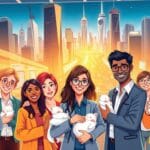Did you know that neurodivergent individuals make up about 15-20% of the population? This large number shows there’s a big group of talented people out there. Companies like Microsoft, SAP, and JP Morgan Chase have realized something important. Not just because it’s the right thing to do, but because it can really help their business. By bringing in people who think differently, companies can come up with new ideas and solve problems in better ways. We’re going to look into how focusing on neurodiversity at work is changing how businesses run and opening up new chances for everyone.
Key Takeaways
- Neurodivergent individuals represent a significant portion of the workforce, bringing unique strengths.
- Companies are increasingly recognizing the cognitive diversity benefits of inclusive hiring.
- Embracing neurodiversity leads to innovation and creative problem-solving.
- Organizations like Microsoft leverage workplace neurodiversity innovation to enhance performance.
- Creating an inclusive environment helps unlock the untapped potential of neurodiverse talent.
What is Neurodiversity and Why It Matters
Neurodiversity is about the different ways our brains and minds work. It covers conditions like Autism Spectrum Disorder (ASD), ADHD, and dyslexia. The idea of neurodiversity shows these differences are natural, not something wrong. It helps us see the value in everyone’s unique brain.
Why does neurodiversity matter? Because it brings unique views and skills. Neurodivergent people can boost problem-solving and add to a team’s success. Workplaces that welcome diverse minds are often more creative and do better.
Understanding the Value of Neurodiverse Talent
Today’s workforce is starting to really value neurodiverse talent recruitment. This approach brings in amazing skills and views that are often missed. The strengths of neurodiverse individuals stand out in tasks like data analysis. Here, their unique way of seeing things leads to new solutions.
Many companies now see that neurodiverse people have great focus and solve problems in incredible ways. These abilities help teams become more creative and dynamic. This helps businesses grow and stay ahead in tough markets.
Using the unique skills of neurodiverse talent can give your organization a competitive edge. An inclusive environment that celebrates differences leads to amazing innovation. It makes your team better and your brand stronger in the market.
The Business Case for Neurodiversity at Work
Workplaces that welcome neurodiversity see clear business benefits. These benefits include more than just being inclusive. Companies that hire neurodiverse individuals get a big boost in productivity. This is because teams with different kinds of thinkers find unique solutions, improving project outcomes.
The return on investment (ROI) for embracing neurodiversity is impressive. Creating an inclusive environment attracts a broader range of talents. It also improves team morale. As a result, teams with neurodiverse members are more innovative. They deliver projects faster and with better quality.
Companies like SAP have nearly 90% retention rates with their neurodiverse employees. This shows the long-term benefits of such hiring practices. Investing in neurodiversity means building a workforce full of varied perspectives. This leads to more innovation and ongoing business success.
Inclusive Hiring Practices for Neurodiverse Candidates
Changing how we recruit is key to finding neurodiverse candidates. Adopting inclusive hiring practices lets us find a wider range of talents. Here are important strategies to make your hiring better:
- Utilize skills-based assessments: Focus on what candidates can do, not just their resumes. Tests of practical skills can uncover abilities that normal interviews might miss.
- Revise job descriptions: Focus on required skills, not personal traits. Use clear language to describe what the job involves. This makes it easier for neurodiverse people to see if they’re a good fit.
- Collaborate with advocacy groups: Work with groups that help with autism hiring. They can offer advice to improve your hiring strategy. These groups offer insights that enhance your recruitment processes.
Companies like SAP and Microsoft are leaders in inclusive hiring. They’ve changed how they interview to help neurodiverse talent succeed. This approach leads to happier and more loyal employees.
Workplace Neurodiversity Innovation: Strategies to Implement
An inclusive workplace needs practical steps to help neurodiverse staff. Making proper adjustments is key for these employees to do well. Companies should make special efforts to meet varied needs, improving both comfort and work output.
Here are some strategies to think about:
- Offer flexible work setups, like remote work or changeable hours, to fit personal needs.
- Create quiet areas using soft colors, materials that block noise, and less clutter to help focus.
- Use simple language, visual aids, and written guides for better communication.
- Build peer support groups for neurodiverse employees to connect and share stories, creating a sense of community.
These DEI innovation strategies do more than help one person. When businesses focus on being open to neurodiversity, they boost not just their team but their whole creative and collaborative culture, too. Being diverse in leadership can make a company stand out as a pioneer, pulling in talent from all backgrounds.
Microsoft’s Neurodiversity Program Success Stories
The Microsoft neurodiversity program is getting lots of praise for its success stories. These stories show how effective autism hiring efforts can be. By changing the way they hire, Microsoft has become more welcoming to people with diverse minds.
At the heart of this program is a “skills academy.” It gets candidates ready for work. This method boosts skills and reduces the stress that comes with usual job interviews. A unique approach to welcoming new employees ensures they feel comfortable in their new roles.
The results? Employees are happier and do better at their work. Many express a sense of value and understanding, resulting in increased productivity. These success stories from the autism hiring program show us that embracing everyone’s unique talents is key to creating new ideas at work.

Enhancing Workplace Environments for Neurodiverse Employees
Making workplaces inclusive requires implementing thoughtful changes that significantly assist neurodiverse employees. One way to achieve this is by implementing workplace accommodations that enhance each employee‘s productivity and comfort. For example, creating quiet areas can cut distractions and make work more efficient.
Adding sensory-friendly spaces with tools to lessen Adjustable lights, noise-canceling headphones, and tactile objects create a workspace that enhances employee productivity. Objects make a workspace where employees can do well.
Additionally, flexible work environments enable employees to work at their peak productivity. This could include the option to work from home or implement customized schedules that cater to various needs and demonstrate employee value.
Big companies like Ernst & Young have started mentorship programs with structured plans to improve workplace culture. These programs offer advice and build relationships that help neurodiverse employees succeed.
By adopting these changes, businesses see more employee participation, better retention, and increased productivity. Creating a supportive space for neurodiverse workers leads to a team that’s innovative and full of new ideas.
Measuring the Impact of Neurodiversity on Business Performance
To see the benefits of neurodiversity in your company, you must look beyond the usual numbers. Knowing about neurodiversity performance metrics helps you check if your efforts are working. Looking at how long employees stay, how teams perform, and how many new ideas come out can give you positive clues.
Stories from big companies like JP Morgan Chase and HP show that teams with diverse minds do better. They prove the positive effects of neurodiversity on business. For example, JP Morgan found that their teams worked better after including neurodiverse individuals. This evidence shows why such efforts matter.
It is also essential to determine how to measure the return on investment (ROI) of neurodiversity initiatives. Seeing the money value of these efforts, like better quality work or more innovation, helps keep the support for these programs strong. By using these numbers, you can better understand and grow an inclusive work environment.

Neurodiversity at Work: Key Trends Shaping Employment Strategies
The business world is changing, and so is the role of neurodiversity in it. Companies are now seeing how valuable it is to have different kinds of thinkers on board. This new focus is changing the way we used to hire and work, leading to more creativity.
There’s a growing trend where companies start autism hiring programs. These programs use the special talents of neurodiverse people as an asset. With more companies doing this, we’re learning how valuable diverse minds are in creating a richer workplace culture.
To keep up, businesses are also changing how they support their workers, especially those who are neurodiverse. They’re offering more training and making workspaces where all kinds of minds can do well. This shows they’re serious about making everyone feel included and valued.
Adopting these new trends can really help your company. It’s not just about hiring talent; it’s about sparking innovation and doing better overall. By welcoming neurodiversity, your business can move forward in exciting ways.
Conclusion
Embracing neurodiversity is more than just a current trend. It’s a big change in thinking about our teams. When we see the worth in neurodiverse talent, we can change how we work for the better. This approach fosters greater creativity and enhances productivity by creating inclusive workplaces for all individuals.
Making our offices more welcoming helps everyone, not just people who think differently. This initiative creates an environment where everyone can share their ideas. It helps us solve problems better together.
Today’s business world is always changing, and bringing neurodiversity into our planning is key. Being open and inclusive lays the groundwork for doing well in the long run. A workplace that values all kinds of minds is ready to take on any challenge with inventiveness and strength.
FAQ
What is neurodiversity?
Neurodiversity is about the various ways human brains and minds work. It includes conditions like autism, ADHD, and dyslexia. This concept shows that these differences are natural. They’re also important for a balanced society.
Why is neurodiversity important in the workplace?
Welcoming neurodiversity at work boosts creativity, problem-solving, and how teams work together. Research indicates that teams with neurodiverse members often do better. This leads to more innovation and better results for businesses.
What skills do neurodivergent individuals bring to the workplace?
Neurodivergent people are often excellent at analyzing data, recognizing patterns, and thinking creatively. They usually pay close attention to details. These attributes can spark a lot of innovation in teams.
How can companies benefit from hiring neurodiverse talent?
Companies that hire neurodiverse people often see clear advantages. They notice increased productivity and more innovation. For example, teams with neurodiverse members can be up to 30% better at tasks that require new ideas.
What are some strategies for inclusive hiring practices?
To hire inclusively, companies should focus on the skills needed for the job. They can work with groups that support neurodiversity. Changing how interviews are done can also help keep neurodiverse talent.
What adjustments can be made to support neurodiverse employees?
To help neurodiverse employees, companies can offer flexible work options and sensory-friendly workspaces. Encouraging clear communication is also beneficial. These changes can make the workplace better for everyone.
Can you provide examples of success stories in neurodiversity hiring?
Microsoft’s program for hiring neurodiverse people is a wonderful example. They’ve changed the way they do interviews to better find neurodiverse talent. This has led to happier employees and better job performance.
How can organizations measure the impact of their neurodiversity initiatives?
Companies can track how well their neurodiverse teams are doing by looking at how long employees stay, how productive teams are, and what new ideas they bring. Stories from companies like JP Morgan Chase and HP show how neurodiverse teams help businesses succeed.
What trends are emerging in neurodiversity and employment?
Today, more companies are starting autism hiring programs. They’re seeing neurodiversity as a way to do better than competitors. Businesses are taking steps to find neurodiverse talent and support diversity, equity, and inclusion.









































































































